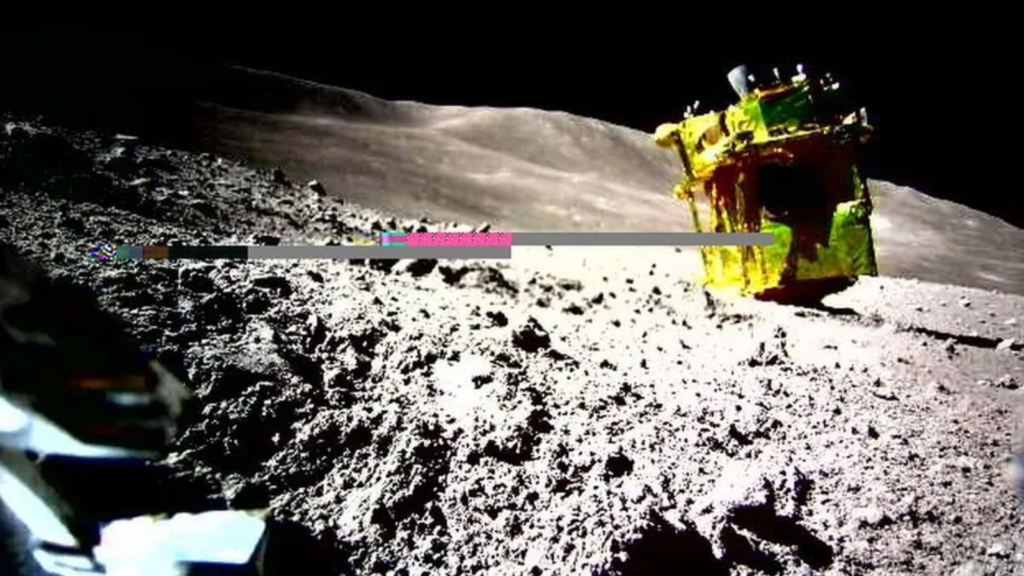
SLIM as seen by LEV-2 on the moon after landing on its nose.
(Image credit: JAXA)
Japan’s Smart Lander for Investigating Moon (SLIM) mission failed to respond to signals sent over the last few days — but all hope is not lost for the tenacious lunar lander.
The Japan Aerospace Exploration Agency (JAXA) attempted to send signals to SLIM on Friday and Saturday (May 24 and May 25), but was met with no response. A final attempt to reestablish contact was made on Monday evening (May 27) to no avail, marking a close to this month’s operations, the space agency announced on SLIM’s official X account.
SLIM, designed to demonstrate accurate lunar landing techniques, touched down on the moon’s surface on Jan. 20. Until now, JAXA has had successful monthly check-ins with the lander in February, March, and April — the probe managed to survive a shocking three frigid lunar nights. Usually, spacecraft can’t even survive one of these two-week periods of cold isolation. Still, the space agency plans to try contacting SLIM again next month when the sun returns to the landing site, in hopes that the lander will reboot with sufficient solar power, the Japan Times reported.
Related: Japan’s SLIM moon lander defies death to survive 3rd frigid lunar night (image)
This is not the first challenge encountered by the SLIM mission. During its landing, one of SLIM’s engine nozzles fell off. While the spacecraft survived the trip — and accomplished its primary goal to soft land within 100 meters (328 feet) of its target landing site — the loss of thrust caused it to land with its solar panels facing away from the lunar morning sun, meaning they would be exposed to less sunlight and thus generate less electricity.
However, by late January, SLIM regained power and was able to resume operations, including sending a panoramic image of its landing site and other data back to Earth.
In its short time on the moon, the SLIM mission has already revealed new insights about the moon’s surface, including evidence of the mineral olivine — the main component of Earth’s upper mantle.
Breaking space news, the latest updates on rocket launches, skywatching events and more!
Olivine is also believed to be the main component of the lunar mantle, which makes up 90% of the moon’s mass. This finding has implications for better understanding the moon’s origin and may support the belief that it formed from debris left behind after Earth collided with another celestial body, according to the Japan Times.
“Further examination is required to determine whether the moon’s olivine actually originated from the Earth’s mantle,” Kazuto Saiki, a professor at Ritsumeikan University, said during a Japan Geoscience Union meeting in Chiba Prefecture on May 27, according to the Japan Times. “But the presence of olivine has been confirmed.”
SLIM represents a new generation of low-cost lunar landers that rely solely on solar cells instead of radioisotope heater units. As a result, the spacecraft was expected to have a shorter operational lifespan and to struggle during cold lunar nights, which extend up to 14 Earth days, with temperatures as low as -274 degrees F (-170° C).
“SLIM has already transmitted far more valuable data than we had ever anticipated prior to launch,” JAXA said in the post on X. “We will continue our recovery efforts to keep it active for as long as possible.”
Join our Space Forums to keep talking space on the latest missions, night sky and more! And if you have a news tip, correction or comment, let us know at: community@space.com.
Samantha Mathewson joined Space.com as an intern in the summer of 2016. She received a B.A. in Journalism and Environmental Science at the University of New Haven, in Connecticut. Previously, her work has been published in Nature World News. When not writing or reading about science, Samantha enjoys traveling to new places and taking photos! You can follow her on Twitter @Sam_Ashley13.
>>> Read full article>>>
Copyright for syndicated content belongs to the linked Source : Space.com – https://www.space.com/japan-slim-mission-unresponsive-jaxa-signal
